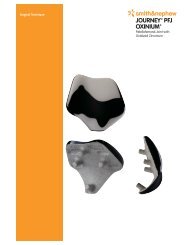Uni- Condylar Knee Surgical Technique - Yorkshire Joint ...
Uni- Condylar Knee Surgical Technique - Yorkshire Joint ...
Uni- Condylar Knee Surgical Technique - Yorkshire Joint ...
You also want an ePaper? Increase the reach of your titles
YUMPU automatically turns print PDFs into web optimized ePapers that Google loves.
Cement <strong>Technique</strong><br />
Femoral component<br />
Apply an even layer of cement on the femoral<br />
prosthesis including the pegs, minimising the<br />
amount applied posteriorly (Figure 41). Pressurise<br />
cement into the cut bone surface digitally or<br />
with a stiff flat surface with sufficient cement to<br />
pressurise cement into the femoral lug holes and<br />
any supplemental drill holes made in sclerotic<br />
bone.<br />
Attach the femoral prosthesis to the femoral<br />
introducer. With the knee flexed to 100° – 110°,<br />
seat the femoral prosthesis. The patella may need<br />
to be retracted to facilitate insertion. With a<br />
mallet, firmly tap the introducer onto the femur<br />
(Figure 42). Release the introducer from the<br />
femoral prosthesis and carefully remove all excess<br />
cement.<br />
Figure 41<br />
When using a metal-backed tibial component<br />
As the tibial and femoral cement cures, re-engage<br />
the tibial trial with the tray and put the leg into<br />
extension. This will maintain compression and<br />
component position until the cement hardens.<br />
After the cement hardens, remove the tibial trial<br />
and introduce the final tibial insert.<br />
Closure<br />
Ensure all excess cement has been removed prior<br />
to closure. The incision is closed in layers.<br />
Figure 42<br />
24





